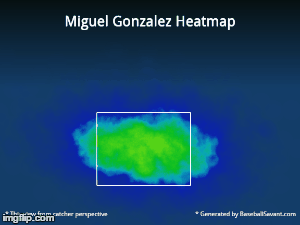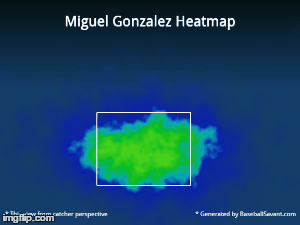This year the Orioles have diverged from T.S. Eliot: August is the cruelest month. Through the heroics of Jason Garcia, the club saw their playoff chances rise as high as 36.2% according to Baseball Prospectus' Playoff Odds modeling. However, that same modeling has now assessed their odds as below 5%. In other words, there is still a chance, but four other clubs stand a better chance at snagging that last Wild Card entry. Also note that this commentary does not include the results from Sunday's games.
If one only considers Games Back, it might still look competitive to some:
| Rk | Tm | W | L | GB | Playoff % | |
|---|---|---|---|---|---|---|
| 1 | KCR | 80 | 49 | .620 | --- | 100 |
| 2 | TOR | 73 | 56 | .566 | --- | 100 |
| 3 | HOU | 72 | 58 | .554 | --- | 98 |
| 4 | NYY | 71 | 57 | .555 | --- | 96 |
| 5 | TEX | 67 | 61 | .523 | --- | 49 |
| 6 | MIN | 66 | 63 | .512 | 1.5 | 16 |
| 7 | LAA | 65 | 64 | .504 | 3.5 | 17 |
| 8 | TBR | 63 | 66 | .496 | 4.5 | 7 |
| 9 | BAL | 63 | 66 | .496 | 4.5 | 4 |
However, I advise that one should consider playoff percentage as it also tries to account for team strength, opposition, and that other clubs are bunch in for the race. The Orioles, 4.5 games back, have a considerably more difficult time leap frogging to the final Wild Card because they have to best four other clubs. This is highly unlikely. One might also remember that it was highly unlikely for the Yankees to crater and lose their first place spot to the Orioles. At the time, their odds were a 75% chance of retaining that position. However, they have given that placement to the Blue Jays for the time being. Point being, we should not expect the Orioles to make the playoffs at this point, but we should also not be shocked if they do. Pleasantly surprised, yes. Shocked, no.
One might remember from previous statements of mine in various media that before a season begins I consider the season in play if a club has a playoff projection about 5%. It might be confusing that that particular red line moves upward during the season for me. It is not that 5% is not 5% is not 5%. By definition, a 5% club in March has the same odds to make the playoffs as a 5% club at the end of August. What differentiates the number for me is that a 5% club at the end of August has better evidenced itself as being a 5% club while one in March may experience certain luck (e.g., health, unexpected breakout seasons) and actually be a better team than initially projected. Additionally, a 5% team in August has less time to improve itself through player acquisitions or uncover fast rising players in the upper minors. Simply said, we know more about a club in August than we do in March, so I feel more comfortable accepting the projection model's odds and the lack of opportunity to improve the level of talent on the squad.
Looking at the legacy of the Showalter / Duquette era...
Boiling up over the past month, there has been a small, but vocal, subgroup of Oriole fandom that has firmly rooted itself into the belief that Buck Showalter needs to be fired. Likewise, a season-long belief that somehow the organization was arrested from action due to the Toronto Blue Jays' inquiry on Dan Duquette has also firmly been entrenched by some as fault for the Orioles not making the playoffs. These two ideas seem incredible to me.
Since 2012, the Orioles have been the winningest team in the American League with a record of 337 wins. For perspective, from 2008 through 2011, the Orioles lost the most games in the American League with 380 losses. Again, the current era turned the worst team in the league into the best team in the league in terms of overall multi-year performance. That speaks to the overwhelming success that Baltimore has seen over the years. Yet, somehow there is a vocal group that is very upset that the current club is 4.5 games outside of the playoffs. That is a bit mind numbing. This club has come so far that some have a Ricky Bobby perspective (If you're not first, you're last).
Showalter is highly esteemed for his ability to manage players and the respect his players show for him. He is the quintessential manager any club would want helming their team. I have yet to read any competent argument indicating otherwise. The only points brought up have been the extent of "Buck looks lost" and "Buck cannot figure out how to win." On the first point, that is pretty much just a collection of words people throw together when they feel something, but cannot find anything tangible to express that feeling. One can simply ignore that as gibberish. The latter, well, it is demonstrably false and also seems to fail in understanding how a baseball season can play out.
With respect to Duquette, I agree in that we should question his competency, but disagree that the will-he-leave-or-won't-he issue amounted to much. Addressing the latter, a front office is a large collection of people and moving parts. Duquette being considered for a different role would not prevent him in acting to better the club. A firm payroll limit likely had more to do in hindering the club in improving its talent base. The firm payroll limit was why the club decided to roll the dice with several fringe outfielders and hope for the best (an approach that worked amazingly well the previous three years). In the end, it did not work out. Sometimes the five or six players you collect wind up all crapping out.
Additionally, there has been some mumblings about Duquette not caring about the direction of the club which also seems demonstrably false. The Jason Garcia situation seems to be the best example that the Orioles are interested in the future of this club. Duquette is not maximizing this season to better himself on the way out. Instead, he is holding on to a fringe power arm prospect to better the club's chances in future seasons.
However, I would like to introduce nuance and explain my displeasure with Duquette. My concern is that the minor league system has not improved from MacPhail's tenure. In fact, it is worse. MacPhail had a system that was a collection of a couple shining elite prospects and a few second tier guys with one or two loud tools. MacPhail also had a system that largely ignored international amateurs and publicly said that a club would be unwise to invest too much in that area. All in all, the few shining prospects often placed the club around 10th best as a farm system. Duquette's system has a couple injured elite prospects and a few second tier guys with low ceilings. Duquette, who came in with an interest in attacking the foreign markets, has a system that largely ignores international amateur talent. This system now finds itself as one of the worst in baseball.
From my perspective, spending a couple million here or there on guys like Delmon Young or Everth Cabrera was misguided. I can understand maybe picking up one of them, but if that prevents you from bringing your international investment up to maximally allowed without incurring a penalty, then that appears to be a poor practice. In effect, I think this results in the club unwilling to acquire top tier international talent as well as being unable to sign a bevy of hard throwing pitchers, which is a reason why Jason Garcia may be more important to the Baltimore organization than say another system with a firm international effort. To be clear, the Orioles annually spend the least or second least money on international amateurs in all of Major League Baseball. I have yet to see any evidence to show that this is a good approach to take.
Yes, I agree that when the playoff window is open that it is important to maximize your resources to push yourself through that window. I contest that an extra two million is going to impact that window much. Maybe it does. Maybe it is too difficult to recognize who is a breakout two million dollar player and who is not, so it makes sense to collect as many as possible. Maybe it makes sense to offer guaranteed contracts to pitchers or hitters who wind up being released in Spring Training. I think it is an approach that has not worked and will unfortunately manifest itself in coming years to those who pay attention.
And now for Arrivals and Departures...
I think we can pass for now. Maybe something fun happens today.












